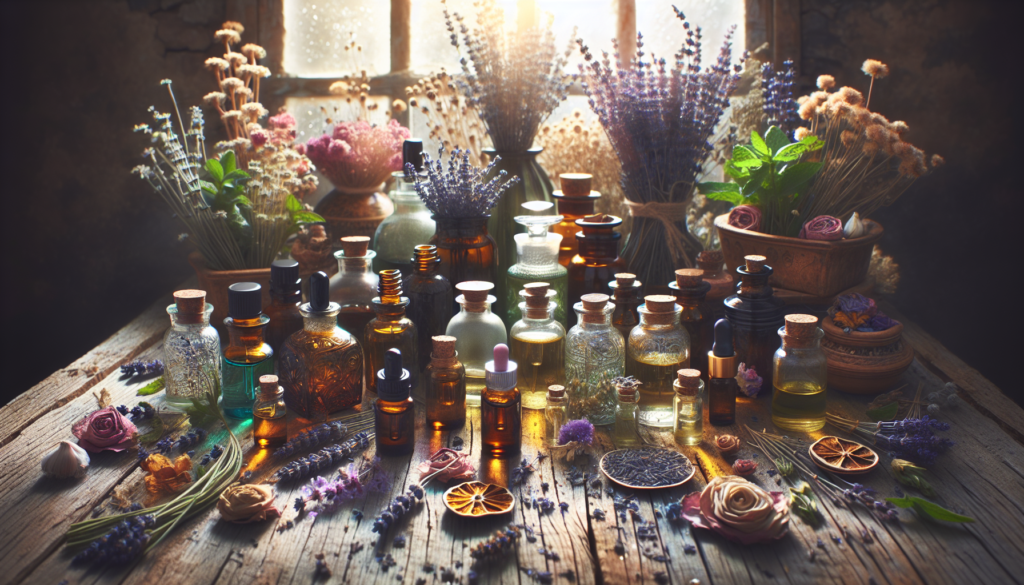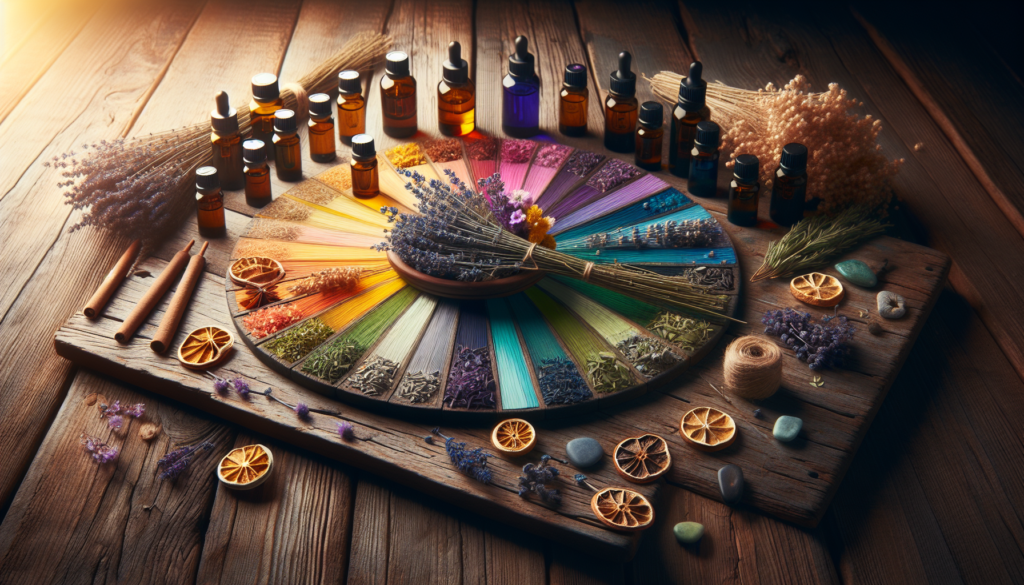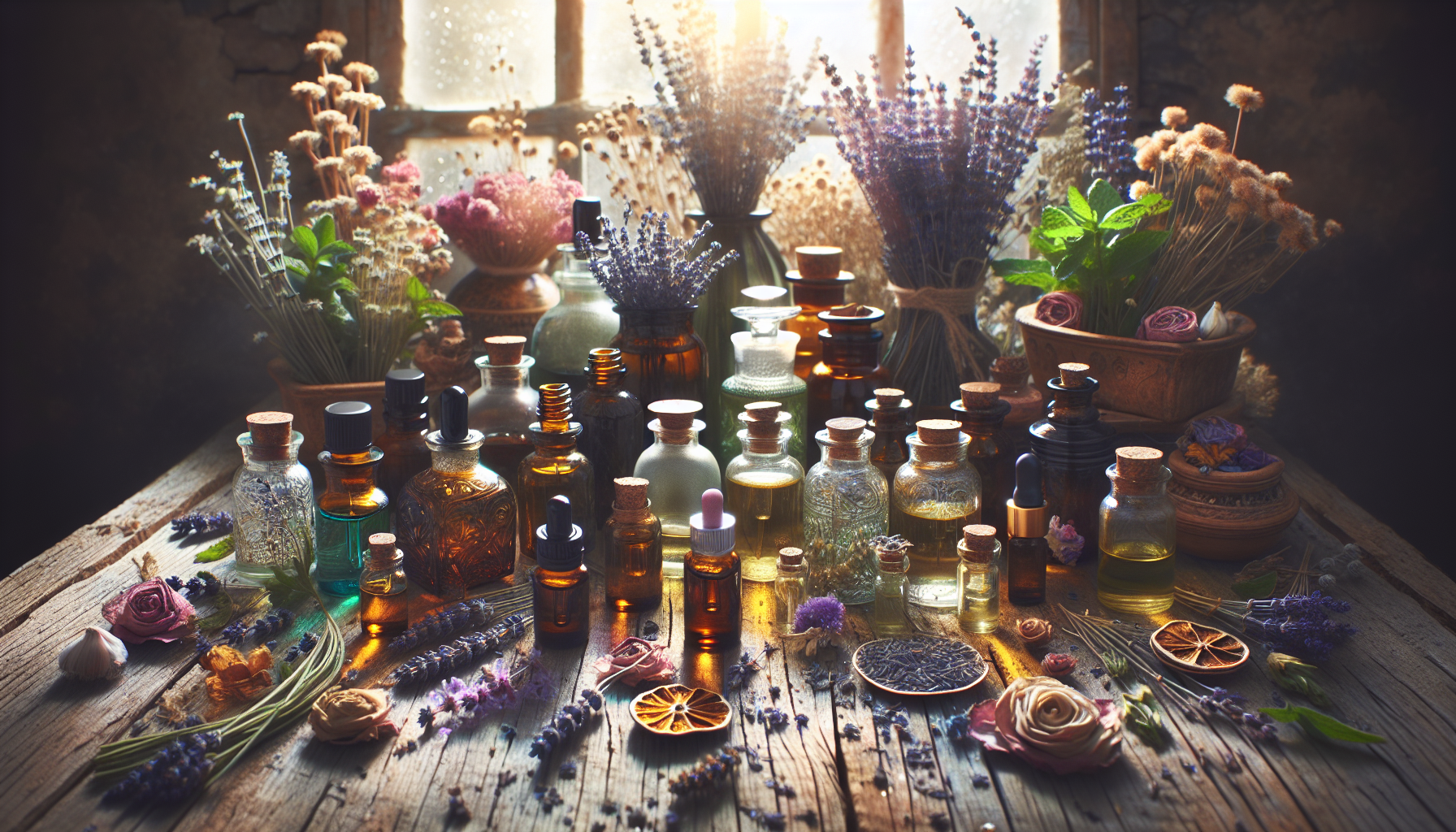Are you curious about the world of aromatherapy? Look no further! In this article, you will discover the essential basics of aromatherapy that will guide you as a beginner. From the benefits of using essential oils to the various methods of application, this guide will equip you with the knowledge you need to start your aromatherapy journey. So, get ready to unlock the power of beautiful scents and their incredible effects on your well-being.

What is Aromatherapy?
Defining Aromatherapy
Aromatherapy is a holistic healing practice that utilizes the natural aromatic compounds found in plants, known as essential oils, to promote physical, emotional, and psychological well-being. It involves the use of these essential oils through various methods of application, such as inhalation, topical application, diffusion, and bathing. The smell of these oils can have a profound impact on our mood, emotions, and overall health, making aromatherapy a popular and effective alternative therapy.
History of Aromatherapy
Aromatherapy has a rich and ancient history that dates back thousands of years. The practice can be traced back to ancient civilizations such as the Egyptians, Greeks, and Romans, who used aromatic plants and their oils for various purposes, including medicinal, spiritual, and cosmetic. The term “aromatherapy” was coined in the early 20th century by a French chemist named Rene-Maurice Gattefosse, who discovered the healing properties of lavender oil when he accidentally burned his hand and found that lavender oil helped to heal the wound and prevent scarring. Since then, aromatherapy has gained widespread recognition and has become a popular natural healing modality.
Benefits of Aromatherapy
Physical Benefits
Aromatherapy offers numerous physical benefits that can support and improve overall health. Certain essential oils have antiseptic, anti-inflammatory, and analgesic properties that can help alleviate pain, reduce inflammation, and promote wound healing. For example, tea tree oil is known for its antimicrobial properties and can be used to treat acne, cuts, and infections. Eucalyptus oil is commonly used for respiratory conditions and can help ease congestion and improve breathing. Peppermint oil is often used for digestive issues, as it can help relieve symptoms such as nausea, bloating, and indigestion.
Emotional and Psychological Benefits
Aromatherapy is widely known for its emotional and psychological benefits. The aroma of essential oils can have a powerful impact on our emotions, helping to uplift our mood, reduce stress, and promote relaxation. Lavender oil, for instance, is known for its calming and soothing properties and is often used to reduce anxiety and promote sleep. Citrus essential oils, such as orange and lemon, are uplifting and energizing, making them great for combating feelings of sadness and fatigue. Frankincense oil is commonly used for meditation and spiritual practices, as it helps to induce a sense of peace and tranquility.
Cognitive Benefits
In addition to its physical and emotional benefits, aromatherapy has also been found to have cognitive benefits. Certain essential oils have stimulating properties that can enhance focus, concentration, and mental clarity. Rosemary oil, for example, has been shown to improve memory and cognitive performance, making it a great oil to use during study or work sessions. Peppermint oil is another oil known for its cognitive benefits, as it can increase alertness and improve mental accuracy. By incorporating aromatherapy into your daily routine, you can enhance your cognitive abilities and promote mental well-being.
Choosing Essential Oils
Understanding Essential Oils
Before diving into the world of aromatherapy, it’s important to have a basic understanding of essential oils. Essential oils are highly concentrated plant extracts that are obtained through various extraction methods, such as steam distillation or cold pressing. These oils capture the aromatic compounds of the plants and contain their therapeutic properties. It’s important to note that essential oils are potent and should be used with caution. They should always be diluted before applying to the skin and used sparingly to avoid adverse reactions.
Popular Essential Oils and Their Benefits
There is a wide range of essential oils available, each with its own unique aroma and therapeutic properties. Some popular essential oils include:
-
Lavender: Known for its calming and relaxing properties, lavender oil helps reduce anxiety, promote sleep, and soothe skin irritations.
-
Peppermint: A refreshing and energizing oil, peppermint helps relieve headaches, improve digestion, and boost mental focus.
-
Tea Tree: With its powerful antimicrobial properties, tea tree oil is commonly used to treat acne, fungal infections, and skin irritations.
-
Eucalyptus: This cooling and decongestant oil is often used to relieve respiratory conditions, such as coughs, colds, and sinus congestion.
-
Lemon: Known for its bright and uplifting scent, lemon oil can help improve mood, boost immunity, and cleanse the air.
Quality and Purity Considerations
When choosing essential oils, it’s crucial to ensure that you are purchasing high-quality, pure oils. Look for oils that are labeled as “100% pure” or “therapeutic grade.” These labels indicate that the oils have undergone rigorous testing and adhere to strict quality standards. Avoid oils that contain synthetic fragrances or additives, as these can diminish the therapeutic benefits of the oil. It’s also important to store essential oils in dark, glass bottles away from direct sunlight to preserve their potency and prevent degradation.
Methods of Application
Inhalation
Inhalation is one of the most common methods of using essential oils. Simply inhaling the aroma of the oils can have a powerful effect on your emotions and overall well-being. You can add a few drops of essential oil to a diffuser and let the scent fill the air, or you can inhale the oil directly from the bottle. Another option is to place a few drops of oil on a tissue or cotton ball and inhale deeply. You can also create a relaxing atmosphere by adding essential oils to a hot bowl of water or a warm bath and inhaling the steam.
Topical Application
Topical application involves applying diluted essential oils directly to the skin. It’s important to dilute essential oils before applying them, as they are highly concentrated and can cause skin irritation or sensitivities if used undiluted. To dilute essential oils, mix a few drops of the essential oil with a carrier oil, such as jojoba oil or sweet almond oil. This helps to spread the essential oil over a larger surface area and prevents any potential skin irritation. Popular areas for topical application include the temples, wrists, or the bottoms of the feet.
Diffusion
Diffusing essential oils is a popular method of enjoying their aromatic benefits. Essential oil diffusers disperse the oils into the air, creating a pleasant and therapeutic environment. There are many types of diffusers available, such as ultrasonic diffusers, nebulizing diffusers, and reed diffusers. Each diffuser works differently but generally involves adding water and a few drops of essential oil to the device for diffusion. Diffusing essential oils can help purify the air, boost mood, and promote relaxation.
Bathing
Adding essential oils to a warm bath is a wonderful way to relax and unwind. Before adding essential oils to your bath, make sure to dilute them with a carrier oil or an emulsifier, such as bath salts or milk. This helps to disperse the essential oils throughout the bathwater and prevents any potential skin irritation. Once diluted, add a few drops of your chosen essential oils to the bath and agitate the water to mix them in. Soak in the bath for at least 15-20 minutes to fully enjoy the therapeutic benefits of the oils.

Safety Precautions
Essential Oil Dilution
As previously mentioned, essential oils should always be diluted before applying them to the skin. This helps to prevent skin irritation or sensitivities, especially for those with sensitive skin. The general rule of thumb is to use a 1-2% dilution, which means adding 1-2 drops of essential oil to every teaspoon (5 mL) of carrier oil. For children, the elderly, or those with compromised immune systems, it’s recommended to use an even lower dilution of 0.5-1%.
Skin Sensitivity and Allergies
It’s important to note that some individuals may be more sensitive or allergic to certain essential oils. Before using a new essential oil, perform a patch test by applying a small amount of diluted oil to a small area of your skin, such as the inside of your wrist or elbow. If any redness, itching, or irritation occurs, discontinue use and try a different oil. People with known allergies or sensitivities should also exercise caution and consult with a healthcare professional before using essential oils.
Pregnancy and Aromatherapy
Pregnant women should exercise caution when using essential oils, as some oils may have contraindications during pregnancy. It’s recommended to consult with a qualified aromatherapist or healthcare professional before using essential oils during pregnancy. Certain essential oils, such as clary sage or rosemary, should be avoided during pregnancy, while others, such as lavender or chamomile, can be used safely in moderation. Always err on the side of caution and seek professional advice when in doubt.
Interactions with Medications
If you’re taking any medications, it’s important to be aware of potential interactions with essential oils. Some essential oils, when taken internally or in high doses, can interact with certain medications, causing adverse effects. It’s crucial to consult with a healthcare professional or pharmacist if you’re using essential oils alongside any medications or have any underlying health conditions. They can provide personalized advice and ensure there are no potential interactions or contraindications.
Storing and Handling Essential Oils
Proper Storage Methods
To maintain the potency and shelf life of essential oils, it’s important to store them correctly. Essential oils should be stored in dark glass bottles, as exposure to sunlight can degrade their quality. Keep the bottles tightly closed when not in use to prevent oxidation. Store the oils in a cool, dry place away from direct sunlight and extreme temperatures. Avoid storing them in the bathroom, as the fluctuations in temperature and humidity can negatively affect the oils. When stored properly, essential oils can last for several years without losing their therapeutic properties.
Avoiding Contamination
To prevent contamination, it’s crucial to handle essential oils properly. Always use clean droppers or pipettes when transferring the oils, and avoid touching the inside of the bottle or dropper with your fingers. This helps to prevent any bacteria or impurities from entering the bottle and contaminating the oil. If you accidentally contaminate an essential oil bottle, it’s best to replace it to ensure the purity and integrity of the oil.
Handling and Disposal
When handling essential oils, it’s important to exercise caution. Essential oils should not be ingested or applied undiluted to the skin, as they can cause irritation or adverse reactions. If accidental ingestion or skin contact occurs, seek medical advice immediately. If you need to dispose of essential oils, do not pour them down the drain or toilet. Instead, mix them with a small amount of carrier oil or throw them in the regular trash. Always read and follow the specific disposal instructions provided by the manufacturer.
Basic Blending Techniques
Understanding Notes in Aromatherapy
When blending essential oils, it’s important to understand the concept of “notes.” Essential oils are classified into three main categories: top notes, middle notes, and base notes. Top notes are the lightest and most volatile oils, with a quick evaporation rate. They provide the initial scent and offer a refreshing and uplifting effect. Middle notes have a moderate evaporation rate and provide the body of the blend, adding complexity and balance to the overall aroma. Base notes are the heaviest and longest-lasting oils, with a slow evaporation rate. They act as fixatives and provide depth and stability to the blend. Understanding these notes will help you create well-balanced and harmonious blends.
Choosing Complementary Essential Oils
When blending essential oils, it’s important to choose oils that complement each other and create a synergistic effect. Consider the therapeutic properties and aroma of each oil and how they will work together to achieve your desired result. For example, if you’re looking to create a calming blend, you may choose lavender and chamomile, as they both have relaxing properties. Experiment with different combinations and ratios to find the perfect blend for your needs.
Blending Ratios and Recipes
Blending ratios will vary depending on the purpose and desired strength of the blend. As a general guideline, start with a 2% dilution for topical blends, which equates to 12 drops of essential oil per ounce (30 mL) of carrier oil. For inhalation or diffusion blends, use 5-10 drops of essential oil per 100 mL of water or according to the recommendations of your diffuser. Keep in mind that essential oils have varying strengths, so it’s important to adjust the ratios accordingly. There are also many resources available, such as books and online guides, that provide ready-to-use recipes for specific purposes, such as relaxation, focus, or immune support.
Creating a Relaxation Ritual
Setting the Mood
Creating a relaxation ritual with aromatherapy involves setting the mood and creating a serene and tranquil environment. Choose a quiet and comfortable space where you can relax without distractions. Dim the lights or use candles to create a soft, soothing ambiance. Play calming music or natural sounds, such as ocean waves or bird songs, to enhance the relaxation experience. Create a cozy atmosphere with soft blankets, pillows, or a comfortable chair. By creating a peaceful environment, you can enhance the effects of aromatherapy and promote deep relaxation.
Choosing Relaxing Essential Oils
When creating a relaxation ritual, choose essential oils known for their calming and soothing properties. Lavender is a popular choice due to its ability to reduce stress and promote sleep. Other relaxing oils include chamomile, ylang-ylang, and bergamot. Consider blending these oils together or using them individually depending on your personal preference. Experiment with different combinations until you find the perfect scent that helps you unwind and relax.
Practicing Mindfulness
Incorporating mindfulness practices into your relaxation ritual can further enhance the benefits of aromatherapy. Mindfulness involves being fully present in the moment and paying attention to your thoughts, feelings, and sensations without judgment. As you inhale the aroma of the essential oils, focus on the sensations and emotions that arise. Take slow, deep breaths and observe the relaxation spreading throughout your body. Engage in calming activities such as meditation, deep breathing exercises, or gentle stretching to further deepen your relaxation experience. By combining aromatherapy with mindfulness, you can create a powerful and rejuvenating self-care practice.
Exploring Aromatherapy Tools and Accessories
Essential Oil Diffusers
Essential oil diffusers are a popular and convenient way to enjoy the benefits of aromatherapy. There are various types of diffusers available, each with its own unique features and benefits. Ultrasonic diffusers use water to disperse the oils into a fine mist, while nebulizing diffusers break down essential oils into microscopic particles for optimal dispersion. Reed diffusers use porous reeds to absorb and release the aroma of the oils, providing a subtle and continuous scent. Choose a diffuser that suits your needs and preferences, whether it’s for a specific room, travel, or personal use.
Carrier Oils
Carrier oils are used to dilute essential oils for topical application. They help to spread the essential oils over a larger surface area and prevent any potential skin irritation. Common carrier oils include jojoba oil, sweet almond oil, coconut oil, and grapeseed oil. Each carrier oil has its own unique properties, such as absorption rate and skin-nourishing benefits. Choose a carrier oil that works best for your skin type and desired outcome, whether it’s moisturizing, soothing, or balancing.
Aromatherapy Jewelry
Aromatherapy jewelry allows you to wear your favorite essential oils throughout the day, enjoying their therapeutic benefits wherever you go. There are various types of aromatherapy jewelry available, such as necklaces, bracelets, and earrings. These pieces of jewelry usually have a small compartment or locket where you can place a few drops of essential oil. As you wear the jewelry, the heat of your body helps to gently diffuse the aroma, creating a personal and portable aromatherapy experience.
Aromatherapy Candles
Aromatherapy candles combine the relaxing ambiance of candlelight with the therapeutic benefits of essential oils. These candles are typically made from soy or beeswax and are infused with essential oils. When lit, the heat from the flame slowly releases the aroma of the essential oils, filling the space with a pleasant scent. Choose candles made from natural, non-toxic materials and avoid those that contain synthetic fragrances or additives. Light an aromatherapy candle during your relaxation rituals or whenever you want to create a calming and soothing atmosphere.
Resources for Further Learning
Books on Aromatherapy
There are numerous books available that delve deeper into the world of aromatherapy. These books offer in-depth information on essential oils, blending techniques, therapeutic applications, and more. Some popular books on aromatherapy include:
- “The Complete Book of Essential Oils and Aromatherapy” by Valerie Ann Worwood
- “The Healing Intelligence of Essential Oils” by Kurt Schnaubelt
- “Aromatherapy for Beginners” by Anne Kennedy
- “The Essential Oils Handbook” by Jennie Harding
Online Courses and Workshops
If you’re looking for a more structured learning experience, online courses and workshops can provide comprehensive education on aromatherapy. Many reputable aromatherapy schools and organizations offer online courses covering various aspects of aromatherapy, such as essential oil safety, blending techniques, and therapeutic applications. These courses often include practical assignments, case studies, and assessments to deepen your understanding and proficiency in aromatherapy.
Certification Programs
For those interested in becoming certified aromatherapists, certification programs are available. These programs provide in-depth education and training in aromatherapy, covering topics such as essential oil chemistry, blending techniques, and client assessment. Certification programs typically require completion of specified coursework, case studies, and examinations to ensure a high level of competency in aromatherapy practice. Becoming a certified aromatherapist allows you to work professionally in the field, providing personalized aromatherapy treatments and consultations.
In conclusion, aromatherapy offers a wide range of benefits for both physical and emotional well-being. By understanding essential oils, their therapeutic properties, and various methods of application, you can incorporate aromatherapy into your daily life. Whether you’re seeking relaxation, mental clarity, or physical support, aromatherapy provides a natural and holistic approach to enhance your overall health and happiness. With the abundance of resources and tools available, you can explore and enjoy the world of aromatherapy with confidence and creativity.

